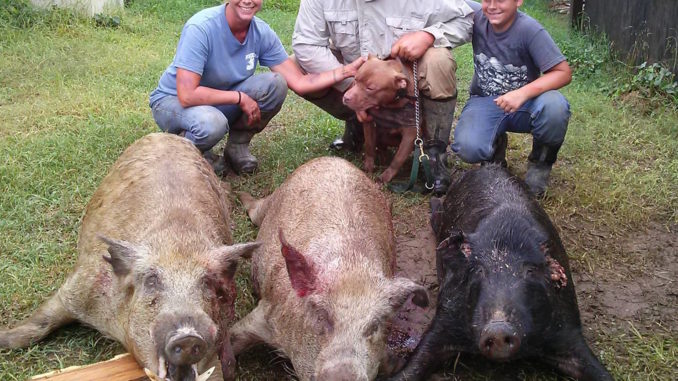
Bay dogs, catch dogs are both necessary parts of the hunt
Hogs are a known nuisance to farmers, landowners, and hunters. They do damage to crops, food plots, and take away food sources and habitat from other game animals. Fortunately, they offer good sport to hunters, and are tasty on the plate. Though they aren’t the most desirable animals for a number of reasons, they do add another game animal for hunters to pursue.
Hogs can be hunted in two main ways – passively from a deer stand, or actively with dogs. Sumter’s Chris Warren chooses to hunt them the active way, and he’s known around the state as the man to call if you want to enjoy a hog hunt, or if you’d like to have some hogs exterminated off your property. He runs Big Country Guide Service, and spends a lot of time running dogs through the fields and woods in search of hogs.
Warren has a stable of dogs that he trains specifically to hunt hogs. His dogs run in silent mode, not barking at all until they’ve found a hog, then they sound the alert while baying the hog, and wait for Warren to move in with the catch dog, which is the dog that is held back until a hog is hemmed up.
“The catch dogs will fight anything at anytime, so you have to hold them back until it is somewhat safe for them. When they see that hog and you release them from their leash, they are going to attack the hog, no matter how big the animal is, no matter how big its tusks are, and no matter how much energy and fight the hog has in it. The bay dogs do a good job of finding the hogs, but they know enough to keep their distance, and just trap the hog,” said Warren, who protects his catch dogs with Kevlar protective gear from Southern Cross Cut Gear.
Watching the dogs work is interesting enough. Once Warren releases them, the dogs spread out, and disappear. They all reappear fairly quickly, as if to check in. Unless Warren motions for them to come to him, they all disappear again. This time they are gone a little bit longer, then they come check in again. Each time they run off, they are running a little bit farther before coming back. Once they’ve found a hog, they stay with the hog.
Warren keeps track of his dogs with GPS collars. He watches a monitoring device that shows him the names and locations of all his dogs. Sometimes Warren will know they have a hog bayed even before he hears them barking. “When you see all the dogs in the same location on the monitor, you know they’ve got a hog bayed,” he said. And that’s when Warren makes his move with the catch dog, which is often a bulldog, or a bulldog-mix.
Once the catch dog moves in and grabs the hog, one hunter grabs the hog by its back legs. This allows another hunter to move in with a knife and make a quick stab straight to the hog’s heart. “For the dogs and other hunters, this is much safer than shooting. For the hogs, this is the quickest and most humane way to kill it,” said Warren, who has killed hogs that range anywhere from 40-pounds up to over 500-pounds.




Be the first to comment